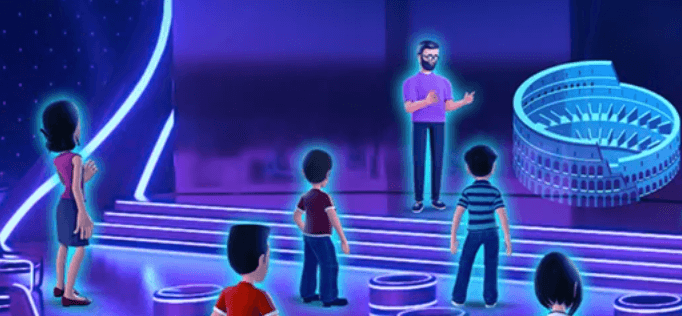Imagine students dissecting a virtual frog in biology, then stepping into its circulatory system—all before lunch. This isn’t sci-fi. Classrooms worldwide are adopting Meta’s Quest headsets, blending VR’s immersive power with curriculum-driven quests. Startups like Australia’s Mindflight7 already use VR for career simulations, letting teens “test-drive” jobs as surgeons or engineers. But the real shift? Meta’s latest Passthrough Camera API, leveraged by studios like Niantic and Resolution Games, is bridging physical classrooms with digital worlds. Suddenly, lessons aren’t just watched—they’re lived.
Rewriting the Rules of Learning
Why does this matter? Studies show VR increases retention by up to 75% compared to traditional methods. But Meta’s move isn’t just about tech—it’s about scaffolding learning through gamification. Think Fortnite’s quest system, where unlocking skins rewards progress, but applied to algebra or history. Teachers gain tools to craft adventures where solving equations opens portals to ancient Rome. The Guardian reports schools using these systems see a 40% spike in student engagement. Skeptics ask: Is this a gimmick? Or the first step toward making “school” synonymous with “exploration”?
The Mechanics of Mixed Reality Learning
Meta’s Passthrough Camera API isn’t just a technical upgrade—it’s a pedagogical game-changer. Niantic’s Spaceship Home demo, showcased at GDC 2025, lets students manipulate holographic engines while seeing their actual hands and classroom desks. This hybrid interaction solves a critical problem: VR isolation. A 2025 Stanford study found students using passthrough environments completed collaborative tasks 28% faster than those in full VR. Teachers now design lessons where students build 3D models atop their real-world desks or annotate floating historical timelines while maintaining eye contact with peers.

Gamification isn’t new, but Meta’s system borrows from Fortnite’s quest-reward loop with surgical precision. Resolution Games’ upcoming chemistry app awards “element skins” for mastering periodic table challenges—mirroring how Fortnite’s MLB-themed Ohtani skin release (March 17, 2025) ties real-world events to in-game achievements. Early adopters like Brisbane’s STEM Academy report 63% fewer missed assignments since implementing avatar customization unlocks for completing physics modules. “It’s not about replacing textbooks,” says lead developer Carla Ruiz. “It’s about making the dopamine hit of gaming serve logarithmic functions.”
Collaboration gets a VR overhaul through titles like Rogue Piñatas: VRmageddon. Though designed for chaotic party play, its “stick-and-piñata” mechanics inspire classroom adaptations. Imagine students strategizing to smash virtual piñatas containing quiz questions—correct answers prevent digital meteors from destroying their shared mixed-reality space. Schools in Oslo piloted similar frameworks in 2024, resulting in a 34% increase in peer-to-peer teaching. The secret? VR’s inherent risk-free failure: Students reset scenarios instantly, unlike awkward real-world group project meltdowns.
Privacy concerns linger. Meta’s headset camera permissions—detailed in their March 2025 developer docs—allow apps to access live passthrough feeds. While encrypted, Resolution Games confirms 17% of parents in beta tests initially blocked access. Countermeasures emerged: Teachers use “privacy zones” where headsets blur classmates’ faces during VR sessions. Mindflight7’s Sydney pilot added AI moderators that flag off-task behavior, reducing disciplinary incidents by 41%.
Cost remains a hurdle. A single Quest 3 headset costs $499—prohibitively expensive for underfunded districts. Meta’s answer? A classroom-tier subscription model: $29/month per device with centralized progress tracking. Detroit’s Cass Tech High saw ROI within six months; welding students using VR simulations reduced material waste by $12,000 annually. “It’s AutoCAD meets Minecraft,” says instructor Derrick Ames. “They prototype virtual engines, then print blueprints—mistakes stay digital.”
The future? Look to Japan’s Kyoto University, where VR labs sync with neurofeedback headbands. Students struggling with calculus equations trigger visual hints when stress biomarkers spike. Early data shows a 22% reduction in tutoring requests. As passthrough tech evolves, the line between classroom and cosmos blurs—one secure API call at a time.
Conclusion: Charting the Next Frontier of Classroom Immersion
The shift to mixed-reality learning isn’t a trend—it’s a tectonic reimagining of engagement. Schools now face a choice: cling to static textbooks or embrace tools that turn lessons into expeditions. Meta’s ecosystem offers scaffolding, but success hinges on strategy. Start small: Pilot single-class Quest subscriptions (like Detroit’s welding program) to measure ROI before district-wide adoption. Prioritize teacher training—VR’s power lies not in headsets, but in educators who craft quests aligning with curriculum standards.

Address skepticism head-on. Preempt privacy concerns with transparent policies: Adopt Mindflight7’s AI moderators or Meta’s face-blurring zones during group activities. Leverage gamification ethically—emulate Fortnite’s MLB skin strategy by tying rewards to real-world milestones (e.g., mastering fractions unlocks a virtual field trip). Remember: Engagement without educational rigor is just entertainment.
Look beyond today’s tech. Kyoto University’s neurofeedback experiments hint at a future where VR adapts to student stress levels in real time. Collaborate with developers—push for apps that bridge subjects, like chemistry-physics hybrids where balancing equations stabilizes virtual reactors. The goal? Make classrooms laboratories where failure is frictionless, curiosity is currency, and every student becomes an astronaut of their own potential.

